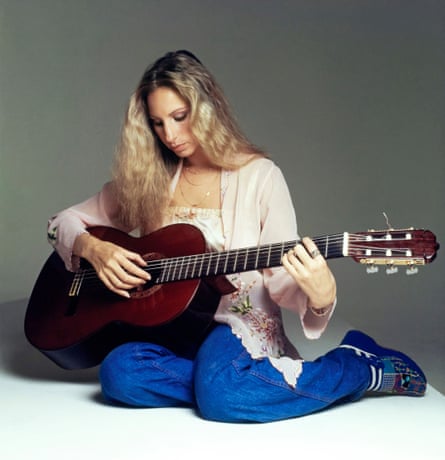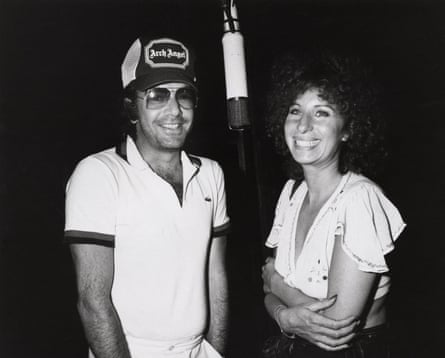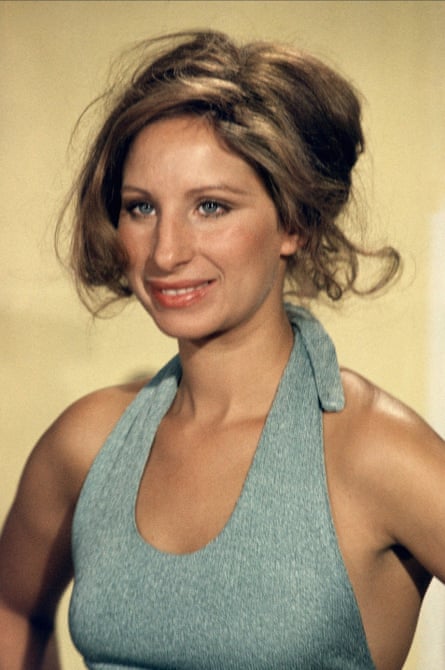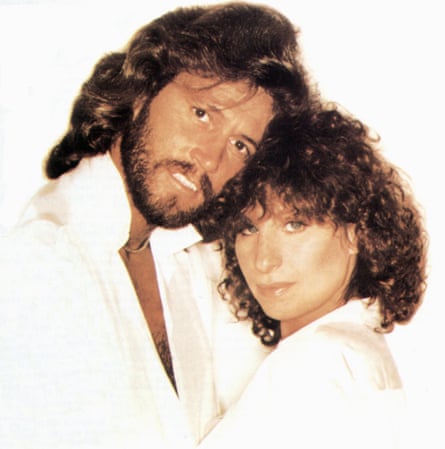20. Guava Jelly (1974)
This entry is being included for its strange and surprising quality: Barbra Streisand performing a Bob Marley song (although it was originally based on Steam’s 1969 hit “Na Na Hey Hey Kiss Him Goodbye”) before the Wailers gained popularity in the US. Oddly enough, it is successful: a playful blend of 1970s pop and soul with a subtle reggae influence in the chorus, and Streisand’s vocals hinting at the song’s seductive undertones.
19. Promises (1980)
Guilty has a hidden treasure that often goes unnoticed due to its two popular songs ranking higher on the list. This song is a sophisticated and subtly charming mid-tempo disco with a catchy chorus. Check out the 12-inch mix for a longer version with enhanced dancefloor appeal.

18. Night of My Life (2005)
Streisand’s previous collaboration with Barry Gibb, Guilty Pleasures, did not achieve the same level of commercial success. However, it was her strongest pop album in many years. In Night of My Life, Gibb breaks away from the Bee Gees’ refusal to revisit the sound of Saturday Night Fever. It can be seen as a small victory.
17. Left in the Dark (1984)
Streisand and Meat Loaf producer/songwriter Jim Steinman should have been a match made in theatrical AOR heaven, but she only worked with him once. Left in the Dark is relatively restrained by Steinman’s standards but is still a riot of booming drums and choral backing vocals with a killer power ballad at its centre.
16. Mother (1971)
Streisand’s rock covers in the 70s were not all successful. David Bowie even expressed his dissatisfaction with her rendition of “Life on Mars.” However, her take on John Lennon’s well-known expression of sorrow is truly remarkable. She replaces the primal-scream-like wailing of the original with an orchestra and gospel organ, yet still manages to capture its emotional impact.
15. Shake Me, Wake Me (When It’s Over) (1975)
In 1975, Streisand surprised listeners with her rendition of Philadelphia International-style dancefloor soul on the album Lazy Afternoon. The tracks feature grand orchestration, wah-wah guitars, and backing vocals reminiscent of the Three Degrees (listen for the When Will I See You Again-inspired sighs at the beginning).

14. You Don’t Bring Me Flowers (1978)
The origin of You Don’t Bring Me Flowers is quite unusual. It was written and sung by Neil Diamond for a sitcom, despite its melancholic tone. Barbra Streisand then covered the song, and a radio program director in Kentucky combined the two versions during his own divorce. The song began to be broadcasted and became a part of 1970s emotional ballad history.
13. The Way He Makes Me Feel (1983)
The song “The Way He Makes Me Feel” could have potentially won an Academy Award for Best Original Song if it hadn’t been competing against another song from Barbra Streisand’s film Yentl, “Papa Can You Hear Me?” Despite the split vote, “The Way He Makes Me Feel” was still a strong contender with its gorgeous melody by Michel Legrand, luxurious orchestral arrangement, and emotional performance by Streisand.
12. People (1964)
Almost didn’t qualify for Funny Girl until Streisand performed it at a preview to enthusiastic reception. It ultimately became one of her most iconic songs, despite the critical comment from Clive James suggesting that the lyrics “people who need people” should have been followed by “are best avoided”.
11. Somewhere (1985)
The standout moment of Streisand’s aptly named album, The Broadway Album, is the concluding track which offers a remarkable reinterpretation of the timeless Bernstein and Sondheim masterpiece. Streisand’s flawless and emotional rendition, accompanied by a lengthy and unexpected electronic introduction, transports the song from its original 1950s setting in Manhattan’s West Side Story to a more contemporary urban landscape.

10. Stoney End (1971)
The Stoney End record aimed to give Streisand a more modern image, featuring covers of songs by Joni Mitchell and Randy Newman, as well as a track titled “Free the People.” While it may not have won over Rolling Stone readers, the standout track “Stoney End” written by Laura Nyro showcases her talent for soulful pop.
9. My Man (1965)
Barbra Streisand’s rendition of Fanny Brice’s theme song was not featured in the 1964 Broadway production of Funny Girl, despite Streisand’s starring role. However, it did make an appearance in the 1968 film adaptation. One may wonder if this choice was influenced by Streisand’s exceptional recording of the song for her album/TV special My Name Is Barbra, released between the two productions.
The song “Enough Is Enough” was released in 1979.
No More Tears can’t really fail: vocal duties shared with Donna Summer, Giorgio Moroder at the peak of his powers in the producer’s seat, a killer ballad-style introduction leading, on the 12in version at least, 10 minutes of hammering synths, OTT rock guitar and frenzied cease-your-bullshit-and-sling-your-hook-pal duetting.
7. Woman in Love (1980)
Pairing Streisand with the Bee Gees was a brilliant decision: despite facing harsh criticism, the talented Gibb brothers were determined to showcase their impressive songwriting skills and poured their hearts into Guilty. The album’s first single reached the top spot in 19 countries, a true testament to its impactful and cinematic quality.

6. Happy Days Are Here Again (1962)
Streisand’s initial triumph was an exception: a record of familiar songs and theatrical tunes by a 21-year-old that achieved immense popularity during the height of Beatlemania. “Happy Days” exemplifies the reason for this: her vocals are astounding, and the slowed-down melody delves beyond the cheerful facade of the lyrics, transforming it into a tune about perseverance rather than happiness.
5. My Father’s Song (1975)
Co-authored by Rupert Holmes, who would go on to release the popular song “Escape” (also known as “The Piña Colada Song”), “My Father’s Song” appears to draw inspiration from Streisand’s own childhood. The lyrics feature a woman reflecting on her father’s death when she was just a year old and the lasting impact he had on her life. Streisand’s heartfelt performance suggests that she truly resonated with the sentiment of the song.
4. Don’t Rain on My Parade (1964)
Other performers have also performed the hit song “Funny Girl” from the musical of the same name, including Bobby Darin and the art-rock band Japan. However, the song is most closely associated with Barbra Streisand, who originally recorded it and is considered to have the best rendition. This may be due to the subtle yet evident touch of desperation she adds to the song’s message of determination and positivity.
3. Evergreen (1976)
Streisand is primarily recognized for her ability to interpret songs rather than write them herself. However, on Evergreen, she solely created the music while Paul Williams wrote the lyrics. It leaves one longing for more of her writing talent as it can be labeled as MOR (Middle of the Road), but of a notably refined and emotionally resonant nature.

2. Guilty (1980)
The Bee Gees, all three of them, contributed to the creation of the standout song on Streisand’s best pop album. The title track flows smoothly, with a soaring melody and subtle soft-rock accompaniment. Streisand’s vocals are exceptional, a notable contrast to Barry Gibb’s, and the chorus is truly magnificent.
1. The Way We Were (1973)
Streisand’s career hit a slump after her unsuccessful album in 1973, which incorporated global music influences. However, her fortunes changed with the release of The Way We Were. This tearjerking and timeless song, which won an Oscar, could easily be mistaken for a classic from the 1940s rather than the 70s. It is beautifully written and showcases Streisand’s ability to display restraint and subtlety in her performance. Pay attention to the way she delivers the line “what’s too painful to remember”, pausing before singing the word “painful” as if it is difficult for her to say. This adds to the impact when she finally unleashes her full vocals at 2.40, making for a cathartic and powerful moment.
Source: theguardian.com



















